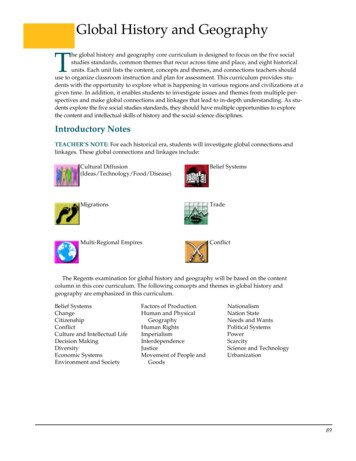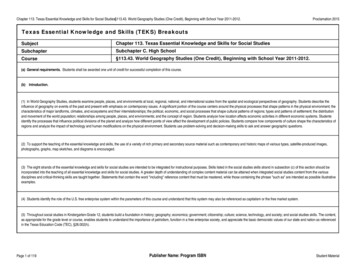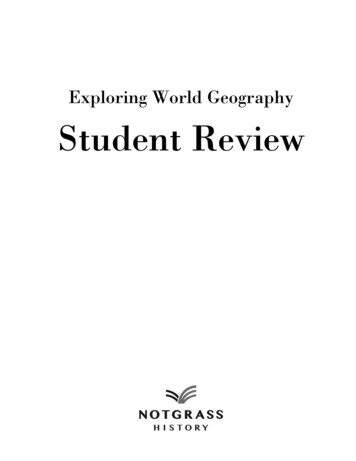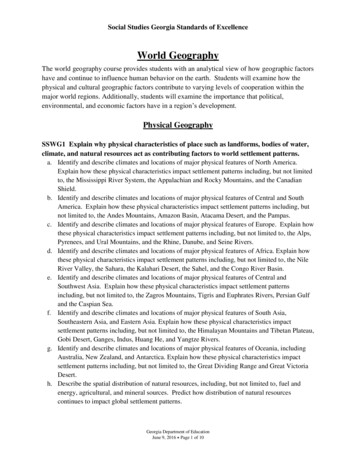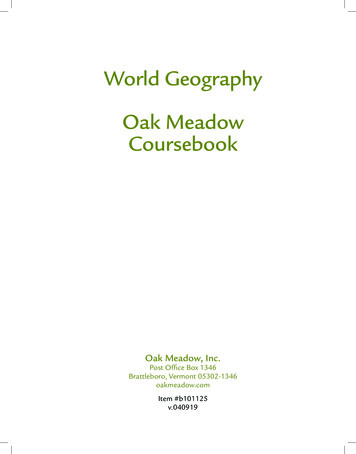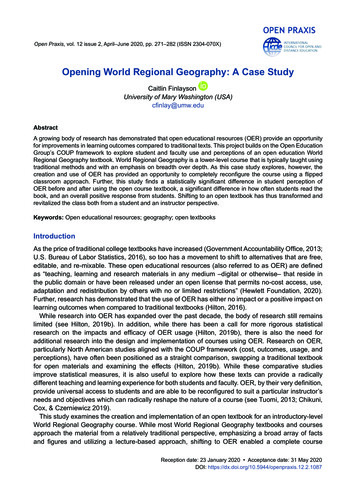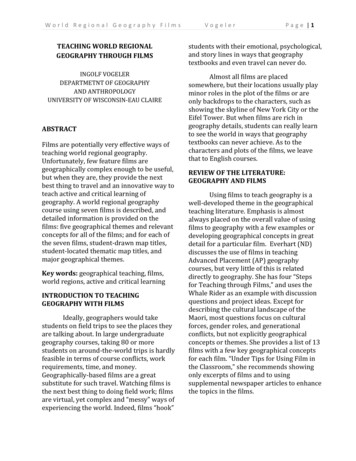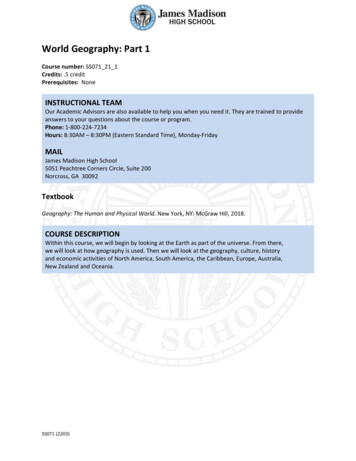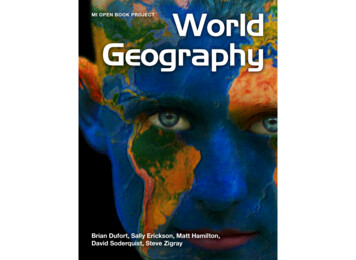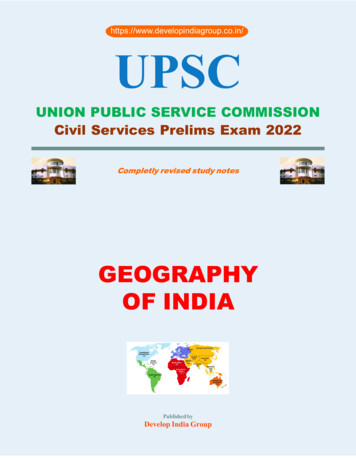
Transcription
https://www.developindiagroup.co.in/General Studies (Paper -1)UNION PUBLIC SERVICE COMMISSIONCivil Services Prelims Exam 2022Completly revised study notesGEOGRAPHYOF INDIAhttps://www.developindiagroup.co.in/Published byNOTES for Civil Services Prelims ExamRevisedNotesDevelopIndiaStudyGroup93
General Studies (Paper -1)GEOGRAPHY OF INDIAGeographical Location of India India is a country of great geographical extent.It belongs to Asia which is the largest continentof the world. It forms a part of south Asia and isseparated by the Himalayas from the rest of thecontinent. In the north are the lofty Himalayas,parts ice-covered. To the south of Himalayas isthe Great Indo-Gangetic Plain. The western partof this vast plain is Thar Desert.India is located at the head of the Indian Ocean.India had a glorious past. Indian Ocean has beennamed by the ancient geographers. Our countryholds a commanding position with respect to theIndian Ocean and a central position in relationto Asia, Africa and Australia. Thus, it enjoys astrategic position especially with reference to theinternational trade route connecting the easternand the western hemispheres.Indian mainland extends in the tropical and subtropical zones from latitude 8 4' north to 37 6'north and from longitude 68 7' east to 97 25' east.The southernmost point in Indian territory, theIndira Point (formerly called Pygmalion Point),is situated at 6 30' north in the Nicobar Islands.The country thus lies wholly in the northern andeastern hemispheres. The northernmost point ofIndia lies in the state of Jammu and Kashmir andit is known as Indira Col.With an area of 32,87,263 sq km India is the seventh largest country of the world after Russia(1,70,75,000 sq km), Canada (99,76,140 sq km),China (95,97,000 sq km), the U.S.A. (93,63,169 sqkm), Brazil (85,11,965 sq km) and Australia(76,82,300 sq km). India accounts for about 2.4per cent of the total surface area of the world.https://www.developindiagroup.co.in/ India country is divided into almost equal partsby the Tropic of Cancer (passes from Jabalpur inMP). The southernmost point in Indian Territory, (inGreat Nicobar Island) is the Indira Point (6 45’),while Kanyakumari, also known as Cape Comorin, is the southernmost point of Indian mainland.The country thus lies wholly in the northern andeastern hemispheres. The 82 30’ E longitude is taken as the StandardTime Meridian of India, as it passes through themiddle of India (from Naini, near Allahabad). India is nearly twenty times as large as GreatBritain, the country which ruled us for about twocenturies. Many of the Indian states are largerthan several countries of the world. Area and Boundaries India stretches 3,214 kmat its maximum from north to south and 2,933km at its maximum from east to west. The total length of the mainland coastline is nearly 6,100 km and the land frontier measures about15,200 km. The total length of the coastline, including islands, is about 7500 km. With an areaof about 32,87,782 sq km, India is the seventhlargest country in the world, accounting forabout 2.4 per cent of total world area. Countrieslarger than India are Russia, Canada, USA, China, Australia and Brazil. In terms of population,however, India is second only to China. India's neighbours in the north are China (Chinese Tibetan Autonomous Region), Nepal andBhutan. The boundary between India and China is called the Mac Mahon Line. To the northwest India shares a boundary mainly with Pakistan and to the east with Myanmar, while Bang-NOTES for Civil Services Prelims Exam Revised Study Notes94
General Studies (Paper -1)ladesh forms almost an enclave within India.Afghanistan is another close neighbour of Indiatowards northwest. The country is shaped somewhat like a triangle with its base in the north(the Himalayas) and a narrow apex in the south(Kanyakumari). South of the Tropic of Cancer the Indian landmass tapers between the Bay of Bengal in theeast and the Arabian Sea in the west. The IndianOcean lies south. The Bay of Bengal and the Arabian Sea are itstwo northward extensions. In the south, on theeastern side, the Gulf of Mannar and the PalkStrait separate India from Sri Lanka. India's Islands include the Andaman and Nicobar Islandsin the Bay of Bengal and the Laccadive (Lakshadweep), Minicoy and Amindive Islands in theArabian Sea. Name of the Country Length of border (in km)Percentage of total length of e Divisions At the time of independence in 1947, India wasdivided into hundreds of small states and principalities. These states were united to form fewerstates of larger size and finally organised in 1956to form 14 states and six union territories. Thisorganisation of Indian states was based upon anumber of criteria, the language being one ofthese. Subsequent to this a number of new states havebeen carved out to meet the aspirations of thelocal people and to meet the developmentalgoals. Presently there are 28 States, six es and one National Capital Territory.Facts about position of statesUP borders the maximum number of States-8(Uttarakhand, HP, Haryana, Rajasthan, M.P.,Chhattisgarh, Jharkhand, Bihar). After UP isAssam, which touches the border of 7 States. Tropic of Cancer passes through 8 States :Gujarat, Rajasthan, MP, Chhattisgarh, Jharkhand,West Bengal, Tripuro, Mizoram. Indian Standard Meridian passes through 5 States: UP, MP, Chhattisgarh, Orissa, AP. 9 States form the coast of India. They are : Gujarat,Maharashtra, Goa, Karnataka, Kerala, TamilNadu. Andhra Pradesh, Orissa and West Bengal. 2 Union Territories, viz. Daman & Diu andPondicherry are also on the coast. The Union Territories of Andaman and NicobarIslands and Lakshadweep are made up of islandsonly.Area Geography & Boundaries Geography India stretches 3,214 km from North to South &2,933 km from East to West. Geography Area of India : 32,87,263 sq. km. Accounts for 2.4% of the total world area androughly 16% of the world population. Mainland India has a coastline of 6,100 km. Including the Lakshadweep and Andaman andNicobar Islands, the coastline measures about7516.6 km. In India, of the total land mass: Plains Geography: 43.3% Plateaus: 27.7% Hills: 18.6% Mountains Geography: 10.7% In the South, on the eastern side, the Gulf ofMannar & the Palk Strait separate India from SriLanka. Total land neighbours: 7 (Pakistan, Afghanistan,China, Nepal, Bhutan, Bangladesh andMyanmar). NOTES for Civil Services Prelims Exam Revised Study Notes95
CIVIL SERVICES EXAMS 2022Complete Study Notes Available @ 6500/Prelims Exam Study Notes Available @ 3000/Revised Main Exam Study Notes Available @ 4000/Our Study Materials Features1. It will be covered all topics according to revised syllabus2. each topics deeply facts analysis3. errorless facts4. revised materials prepared by last three year papers analysisCALL FOR MORE : 91 8756987953
Why should read “DevelopIndia Group” Study Material?Msosyi bafM;k xzqi v/;;u lkexzh dks D;ksa i uk pkfg,\1- Develop India Group (DIG) is India’s largest complete study materials provider website. Msosyi bafM;k xzqi (DIG) Hkkjr dh lclscM h v/;;u lkexzh çnkrk osclkbV gSA2- Develop India Group (DIG) prepared their study materials in the guidance of highly qualified and experience mentoringspecialist- Msosyi bafM;k xzqi (DIG) us lq;ksX; vkSj vuqHkoh lykg fo'ks"kKksa ds ekxZn'kZu esa viuh v/;;u lkexzh rS;kj dh gSA3- Develop India Group (DIG) study materials have been prepared strictly according to revised syllabus - Msosyi bafM;k xzqi (DIG)v/;;u lkexzh iw.kZr;k la'kksf/kr ikBîØe ds vuqlkj rS;kj dh xbZ gSA4- Only aim behind preparing these study materials is to provide study material to those students, who are unable to attendcoaching classes in mega cities- bu v/;;u lkefxz;ksa dks rS;kj djus dk mís'; dsoy mu Nk ksa dks v/;;u lkexzh çnku djuk gS] tks egkuxjksaesa dksfpax Dyklsl esa Hkkx ysus esa vleFkZ gSaA5- All kind of facts & data in this material have been collected from authentic sources- bl lkexzh esa lHkh çdkj ds rF;ksa vkSj MsVk dksçkekf.kd lzksrksa ls ,d fd;k x;k gSA6- All kind of data is updated in quarterly in our study notes- gekjh v/;;u lkefxz;ksa esa lHkh çdkj ds vkad³ksa dks frekgh esa viMsVfd;k tkrk gSA7- Develop India Group (DIG) study materials have been prepared in simple language so that student can memorize easily andbetter understand- Msosyi bafM;k xzqi (DIG) v/;;u lkexzh ljy Hkk"kk esa rS;kj dh xbZ gS rkfd Nk vklkuh ls vkSj csgrj ax ls le ldsA8- Complete syllabus of preliminary and main exam has been covered in this study material- çkjafHkd vkSj eq[; ijh{kk dk iwjkikBîØe bl v/;;u lkexzh esa 'kkfey fd;k x;k gSA9- All important and relevant points have been highlighted in bold, underline and italic ways- cksYM] js[kkadu vkSj bVSfyd rjhds lslHkh egRoiw.kZ vkSj çklafxd fcanqvksa dks gkbykbV fd;k x;k gSA10- We have prepared our study materials with trained, talented, experienced team for each subject. They are supported by subjectexperts- geus çR;sd fo"k; ds fy, çf'kf{kr] çfrHkk'kkyh] vuqHkoh Vhe ds lkFk vkSj fo"k; fo'ks"kKksa ds ekxZn'kZu esa v/;;u lkexzh rS;kj dh gSA11- Once you will read these study materials, you will surely find 70 to 80 % questions in next coming examination - ,d ckj tcvki ;s v/;;u lkexzh i ysaxs] rks vkidks fuf'pr :i ls vkus okyh ijh{kk esa 70 ls 80% ç'u feysaxsaA12- So BUY TODAY and secure your future- blfy, vkt gh [kjhnsa vkSj viuk Hkfo"; lqjf{kr djsa-Call us for more details : 91 8756987953
General Studies (Paper -1)GEOGRAPHY OF WORLDCosmology Important Facts The Universe or the Cosmos, as perceived today, consists of millions of Galaxies. A galaxy isa huge congregation of stars held together bythe forces of gravity.Edwin Hubble in 1924 first demonstrated existence of galaxies beyond Milky Way. He provedthat these galaxies are flying away from eachother and that the farther they are, the fasterthey fly. This means that the universe is expanding like a balloon that is being blown up.In the ancient times, the knowledge about theuniverse was vague and confined to mystery andreligious perceptions.In 140 AD, Ptolemy propounded the theory thatthe earth was the centre of the universe and thesun and other heavenly bodies revolved aroundit. In 1543, Copernicus argued that the sun andnot the earth was the centre of the universe.However, he still equated the universe with thesolar system. Kepler supported Copernicus butsaid that the sun was the centre of the solar system and not the universe. In 1805, Hershel madeit clear that the solar system was a part of themuch larger system of stars called galaxy.Our galaxy is Milky Way Galaxy (or the AkashGanga). It is spiral in shape. It consists of over a100 billion stars rotating and revolving about itscentre. Nearest galaxy to ours is Andromeda.The Big Bang Theory evaluates that 15 billionyears ago, cosmic matter (universe) was in anextremely compressed state, from which expansion started by a primordial explosion. This explosion broke up the super-dense ball and casthttps://www.developindiagroup.co.in/ its fragments far out into space, where they arestill traveling at thousands of miles per second.It is from these speeding fragments of matterthat our galaxies have been formed. The formation of galaxies and stars has not halted the speedof expansion. And, as it happens in all explosions,the farthest pieces are flying the fastest.Later, Pulsating (Oscillating) Universe Theorywas given which says that universe periodicallyexpands from the explosion of the primordialbody, then contracts back and explodes again,over immensely long cycles, ad infinitum.Measurement Units of Space are :Light Year : It is the distance covered by light inone year in vacuum at a speed of 3 105 km/s.Astronomical Unit (A.U) : It is the mean distance between the earth and the sun. One lightyear is equal to 60,000 A.U.Parsec : It represents the distance at which themean radius of earth's orbit subtends an angleof one second of an arc. It is equal to 3.26 lightyears.Stars are self - luminous bodies that account for98 per cent of the material in the galaxy. Therest 2 per cent consists of interstellar or galacticgas and dust in an attenuated form.Stars are formed by gravitational contractionsfrom these vast clouds of galactic gas and dust.Star forming clouds are thousands of timesdenser than the normal interstellar gas. Starforming matter is richer in hydrogen and helium.A star's colour indicates the temperature of itssurface. Blue colour denotes maximum temperature. Then comes yellow, then red, etc.The life of a star is spread over billions of years.It begins to form by compression of galactic gasNOTES for Civil Services Prelims Exam Revised Study Notes139
General Studies (Paper -1) and dust. Compression generates heat which inturn causes hydrogen to be converted into helium in nuclear fusion, thereby emitting largeamount of heat and light.Continued nuclear fusion over a period of timestarts depletion of hydrogen and the helium corebecomes increasingly heavy, resulting into swelling and reddening of outer regions. Such starsof gigantic dimensions are termed as Red Giants.If the star is of sun's size, it becomes a WhiteDwarf. Their central density can reach up to 10?grams per cubic cm.If die star is bigger than the sun but not morethan twice as big, it will turn into a Neutron Staror Pulsar. Their central density is 1014 grams percubic cm. They are formed due to Novae or Super novae explosion.Stars having mass greater than three times thatof the sun, because of their great gravitationalpower, have contracted so much that they havedeveloped super density of 1016 grams per cubic cm. It is so dense that nothing, not even light,can escape from its gravity and hence called'Black Hole'.Brightest star outside our Solar System is Sirius,also called Dog Star.Closest star of Solar System is Proxima Centauri(4.2 light years away). Then come Alpha Centauri(4.3 light years away) and Barnard's Star (5.9light years away).Earth Solar SystemEarth solar system consists of :The SunThe PlanetsDwarf Planetsand countless fragments of left - overs calledasteroids, meteors, comets and satellites of theplanets (Called small solar system Bodies).Origin of Solar SystemVarious theories have been given by differentpersons to explain the origin of Solar System. Gaseous HypothesisKant Nebular HypothesisLaplace Planetesimal HypothesisChamberlin andMoulton Tidal HypothesisJames Jeans & HaroldJeffrey Binary Star HypothesisH. N. Russel Fission HypothesisRoss Gun Cepheid HypothesisA.C. Banerji Nova HypothesisHoyle & Lyttleton Electromagnetic HypothesisH. Alfven Interstellar Dust HypothesisSchmidt Nebular Cloud Hypothesis Dr. Von Weizsacker Protoplanet HypothesisG. KuiperSolar System Some Facts https://www.developindiagroup.co.in/Biggest PlanetSmallest PlanetNearest Planet to SunFarthest Planet from SunNearest Planet to EarthBrightest PlanetBrightest star after SunPlanet with maximum satellitesColdest PlanetHottest PlanetHeaviest PlanetRed PlanetBiggest SatelliteSmallest SatelliteBlue PlanetMorning/Evening StarEarth's TwinGreen PlanetPlanet with a big red spotNOTES for Civil Services Prelims Exam Revised Study enusVenusNeptuneJupiter140
STATES PSCS EXAMS 2022Each State PSC like UPPCS, HPAS, CGPSC, JPSC, BPSC, MPPSC, OAS ExamComplete Study Notes Available @ 6500/Prelims Exam Study Notes Available @ 3000/Revised Main Exam Study Notes Available @ 4000/Our Study Materials Features1. It will be covered all topics according to revised syllabus2. each topics deeply facts analysis3. errorless facts4. revised materials prepared by last three year papers analysisCALL US FOR MORE : 91 8756987953
General Studies (Paper -1)ALL JUDICIAL SERVICES EXAMS 2022Each State PSC like UPPCS (j), Haryana Judiciary, MP Judiciary, Jharkhand Judiciary,Chhattisgarh Judiciary, Punjab Judiciary, Rajasthan Judiciary etc.COMPLETE STUDY NOTES AVAILABLE @ 6500/Prelims Exam Study Notes Available @ 3000/Revised Main Exam Study Notes Available @ 4000/Our Study Materials Features1. It will be covered all topics according to revised syllabus2. with case law analysis3. latest updated study notes4. revised materials prepared by last three year papers analysisCALL US FOR MORE : 91 S for Civil Services Prelims Exam Revised Study Notes142
Geography Area of India : 32,87,263 sq. km. Accounts for 2.4% of the total world area and roughly 16% of the world population. 3. Mainland India has a coastline of 6,100 km. Including the Lakshadweep and Andaman and Nicobar Islands, the coastline measures about 7516.6 km. 4. In India, of the to
